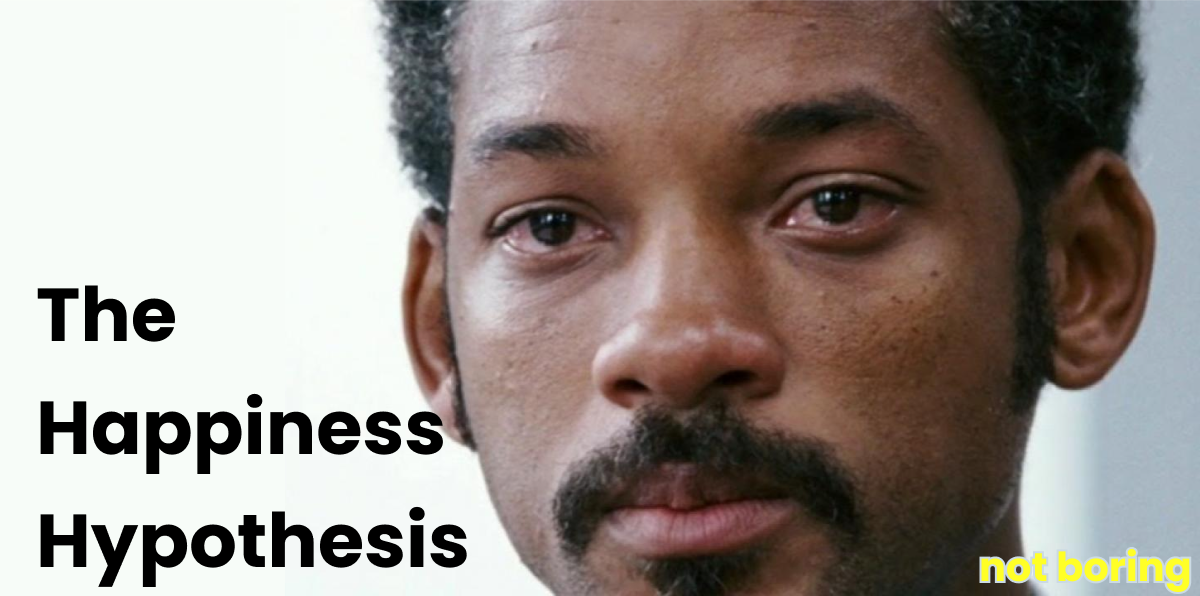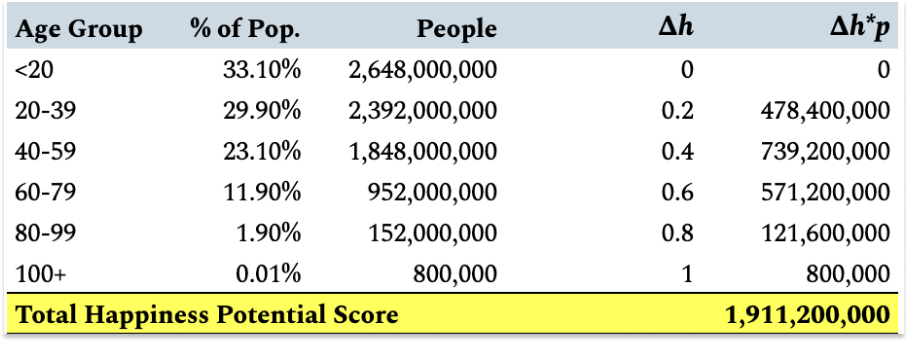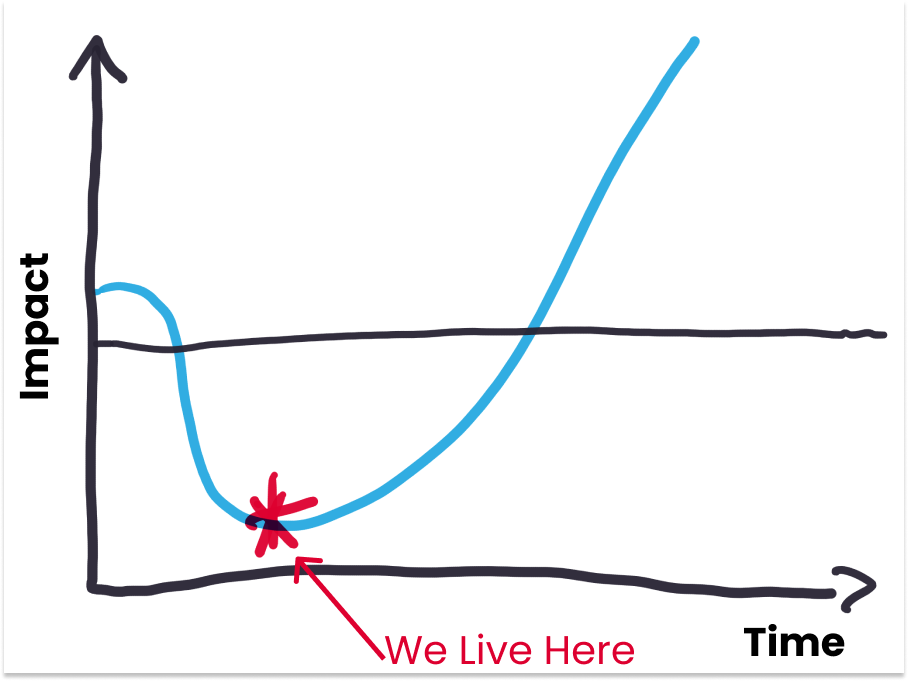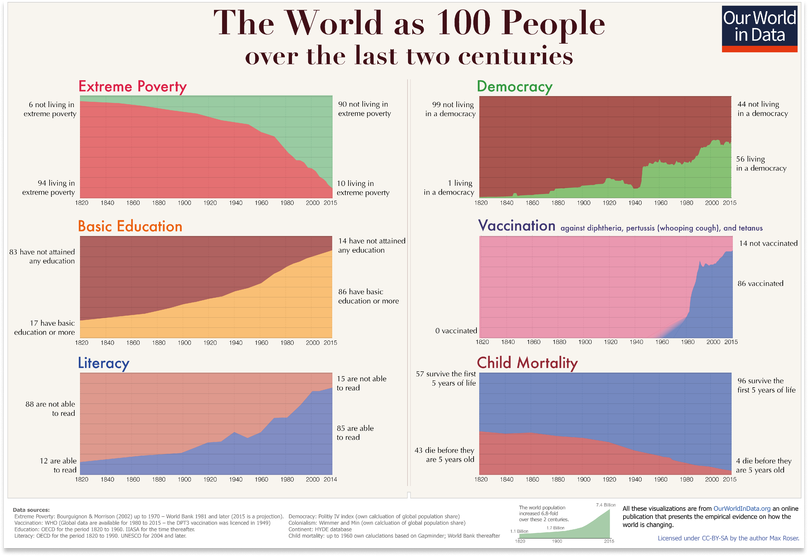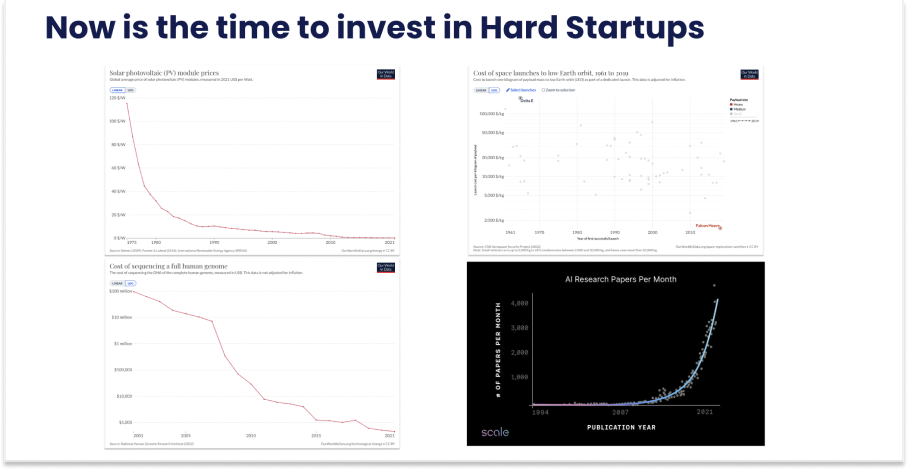Not Boring by Packy McCormick - The Happiness Hypothesis
Welcome to the 3,463 newly Not Boring people who have joined us over the past two weeks! If you haven’t subscribed, join 192,831 smart, curious folks by subscribing here: Today’s Not Boring is brought to you by… Oceans Oceans is a white glove outsourcing firm purpose built to help small businesses, busy executives, and high growth companies easily find and work with the best global talent in operational roles. All Oceans talent comes from Sri Lanka. Why Sri Lanka? Simple: it has the best talent-to-price ratio on the planet. Oceans recruits, vets, trains, and employs top talent in the region from name brand firms and universities. You pay between $2,500 - $3,500 per month for a full time, embedded team member with 5-10 years of experience. That’s ~$36K/yr for talent that would cost $150K+ (easily) in the US. They are already serving clients like Austin Reif (Morning Brew), Ndamukong Suh (Philadelphia Eagles), Joe McCann (Asymmetric Financial) and dozens of high growth SMBs. So if you’re looking for top, affordable talent to take on operational roles (EA+, Operations, Sales/Marketing, Finance, Back Office), check out Oceans. Hi friends 👋, Happy Monday! Hope you all had a great weekend. I didn’t want to write about SVB. Everyone wrote about SVB. Some were qualified to write about, some were making it up. What’s happening in the banking sector is an important story, but it’s not one that I can add much to. Part of the SVB situation that caught me off guard though, and that is more up Not Boring’s alley, is the strength of the anti-tech sentiment that’s emerged in its wake. That’s something I wanted to write about. I’ve started about 15 drafts, trying to figure out what I wanted to say and how to say it. Here’s number 16. Let’s get to it. The Happiness HypothesisPeople don’t seem to like the tech industry as much as the tech industry likes itself. A small group is unhappy with technology generally, a larger one is unhappy with the tech industry as it stands today, and an even larger one is unhappy with venture capitalists. One Slate writer is particularly unhappy with VCs, opining on Twitter, “Euthanizing them is imperative if we want a better world.” (Don’t worry, the euthanization thing was just a John Maynard Keynes reference lol!) While the Slate writer’s opinion is intentionally extreme and incendiary, tens of thousands of people, from anonymous Twitter accounts to sitting Senators, have spent the past ten days expressing their distaste for tech, tech bros, the tech industry, and VCs. Tech has become a punching bag for the left, which paints it as too libertarian, and the right, which paints it as too woke. In response, people in tech have begun mounting defenses and offensives. Every’s Evan Armstrong wrote a good piece arguing that Technology is Good Actually. Pirate Wire’s Mike Solana proposed industry collaboration and influence via political lobbying. Many, many tweeters have pointed out the irony of people complaining about tech on (venture-backed) Twitter from their (venture-backed) iPhone. If you want to get into the nitty gritty of the back and forth on whether VCs are evil and tech is bad, there are a lot of interesting reads and listens out there. To me, the much more interesting question is not who’s right or who’s wrong, but why people feel the way they do about the tech industry and how to fix it. Even the most junior product manager would get fired for blaming users for not understanding the amazing UX they created; if people are the users of technology, the tech industry’s job isn’t to tell them why they’re wrong for not getting how wonderful tech is, but to listen and figure out how to create a better user experience. I’m not sure this is the essay I would have written a couple weeks ago. Over the past few weeks, though, in the comments section of our Weekly Doses #30 and #31, a reader named Ernest Prabhakar made some excellent points about Not Boring’s approach. Essentially, in nicer words, he pushed me to think about why not everyone is as techno-optimistic as I am instead of jamming my vision of progress down their throats. In response to The AppetiZIRP, he made the challenge more clear: This essay is my best effort at identifying the source of the issue. It might be a little rambling, because the issue is complex and multifaceted and involves all sorts of people and products with all sorts of goals and approaches. I’ll go into everything in more depth throughout, but if I had to boil it down, it would go something like this: The purpose of technology is to increase the potential for happiness, but most people don’t feel like technology makes them much happier. In fact, in the short-term, technology can make many feel unhappy — the gains from new technologies are unevenly distributed at the beginning, and ever-increasing efficiency creates a meaning vacuum that needs to be filled. Let’s flesh that out, starting with the fundamental question: what is technology for? What is Technology For?The purpose of technology is to increase the potential for human happiness. In some sense, “What is technology for?” is an impossible question to answer. Each company or person creates or adopts each very specific technology for a very specific reason – there’s always a Job to Be Done – so the question is impractically grandiose. Pondering the ultimate purpose of technology is like pondering the meaning of life. Maybe the AI can help. ChatGPT tells me that “Technology is a tool that is used to solve problems and make tasks easier and more efficient. Its purpose is to improve our daily lives and help us accomplish things that would be difficult or impossible to do without it.” But which problems? Which tasks? Which things? Improve our daily lives, how, exactly? Why? If technology is a “bicycle for the mind,” or a lever that humans use to do the things we want to do more easily and efficiently, then determining what to do with technology is a matter of asking what humanity’s goals are in the first place. Why are we here? It’s a personal question, and maybe an unanswerable one, but given the expected pace and type of technological progress in the coming years, it’s worth trying to come up with something that’s close enough to right to be actionable. In The Purpose of Technology, Balaji proposed an answer: “If the proximate purpose of technology is to reduce scarcity, the ultimate purpose of technology is to eliminate mortality.” We can go a level deeper. Why do we want to reduce scarcity? Why do we want to eliminate mortality? I think it all comes back to increasing the potential for human happiness, moment-to-moment, day-to-day. Potential is the key word here. Even the Founding Fathers, while promising Life and Liberty themselves to be unalienable rights, could only grant the right to the Pursuit of Happiness. Reducing scarcity and eliminating mortality increase the potential for human happiness. Living longer, healthier lives means more time to enjoy life. Reducing suffering and loss means less time suffering and grieving. But smaller things – the ability to reconnect with old friends, make more money in fewer hours, learn about things that fascinate you, experience the wonder of magical technology – increase the potential for human happiness, too. Just how good a certain technology might be at serving its purpose can be gauged based on its ability to increase the potential for human happiness. Happiness is, of course, a hard thing to pin down. The World Happiness Report uses six factors – levels of GDP, life expectancy, generosity, social support, freedom, and corruption – to rank countries by Happiness, but it’s necessarily imprecise. But for a second, let’s assume Happiness can be measured (or that you can picture it in your mind), then the formula for the goodness of a technology might look like:  Where Δh is the change in happiness potential in people impacted by the technology on a scale of -1 to 1, and p is the number of people the technology impacts. Reversing aging is the closest thing in the list to Balaji’s ultimate goal of eliminating mortality, so let’s use that as an example. Reversing aging has the potential to impact all 8 billion people alive today, and the billions or trillions of people alive in the future (but for now, let’s limit it to people alive today). We can also assume that the happiness gained from reversing aging increases with age, and that if you don’t want your aging reversed (say, if you’re under 20), you can opt-out. That’s a Total Happiness Potential Score of 1,911,200,000, which is of course meaningless in isolation and relies on my guesses at happiness increases in this example, but can be used to compare the technology with others. A slightly better CRM, for example, might make people who use existing CRMs slightly happier – they’re slightly less frustrated at work and have slightly more time to do better things than email people or interact with their CRM. Even being very generous with the number of CRM users in the world, though, and assuming that this slightly better CRM could touch all of those users, the Total Happiness Potential Score from a slightly better CRM is 3,200,000, just 0.17% of Reversing Aging. So there’s our answer, right? If the tech industry wants to gain broad support, it needs to stop spending so much time and money on personal CRMs and spend more time and money on reversing aging. Every investment committee should include a Total Happiness Potential Score in its investment criteria. Then, we will stop creating silly things that don’t add value to most peoples’ lives and focus all of our attention on the things that do. Not so fast. Of course, this score is a dramatic oversimplification of the issue at hand, because the world is a complex adaptive system, and technologies interact with each other and with other parts of our lives. What if someone uses their slightly better CRM to make a connection with someone who they team up with to cure cancer? What if we figure out how to reverse aging before we figure out how to make enough food for everyone without killing the planet? Pulling in some more examples, how would you measure Twitter? On the one hand, it’s been a boon for human connection. Used right, I stand by what I wrote in The Great Online Game. On the other, do most of the people on Twitter seem like they’re very happy to be there? I deleted the Twitter app on Friday, and I already feel happier. Twitter’s impact on happiness probably nets out somewhere near zero, both at the population level and the individual level. So the gotchas about tweeting mean things about tech from Twitter aren’t as gotcha as they seem. The purpose of technology is not to be used, but to increase the potential for happiness. Cigarette company executives don’t defend their profits by pointing out that your yellow-nailed hand is twitching near your pocket, dying to grab the pack. At best, a Total Happiness Potential Score can be a quick and dirty check on how much particular technology could possibly increase the potential for happiness. But even then, it’s messy. Innovation isn’t a top down thing; it’s a complex adaptive system. You might look at the fact that B2B software, which, let’s be honest, doesn’t make people that happy, has generated most of tech’s returns over the past decade as proof positive that greedy VCs are only after high margins, making the world a better place be damned. You might, if made Dictator of Venture Capital, forbid funding of B2B software and redirect resources to education or housing or healthcare. If you did, would you be like that butterfly flapping its wings and setting off a typhoon? Would the removal of a certain product, or a certain software innovation inside of a certain B2B company, make it less likely that the education or housing or healthcare companies of the future succeed? Would lower venture returns over the past decade mean less venture capital dollars available today to fund experiments in climate tech and biotech and space? Certainly, if you’d redirected funding from Graphics Processing Units (GPUs) because better graphics in video games weren’t really important, or from all of the blogs and Reddits and Twitters and cat pic sites on the internet because they were a waste of time, we wouldn’t be in the middle of the AI renaissance we are today. My suspicion is that while a lot of the past few decades’ innovation in the world of Bits doesn’t feel like it directly increases the potential for happiness as much as the wave of innovation in Atoms that stalled in the 1970s did, the coming period at the intersection of Bits and Atoms will. Of course, VCs funded and will continue to fund dumb stuff, and a lot of big bets blew up spectacularly and will continue to blow up spectacularly, and if you offered them a Magic FTX Eraser, a lot of people on that cap table would use it without question. At the same time, I think it’s beautiful that we have an asset class in which a handful of winners can fund a whole lot of potentially useful but ultimately unsuccessful experiments. Overall, the many decisions made by often-selfish, sometimes-altruistic agents add up to the greatest innovation engine the world has ever seen. But a lot of that innovation still lies in the future, whereas we’re forced to live in the present. Technology, like banks, has a duration mismatch problem. The Duration MismatchOne of the fun things about crises is that we all get to learn new stuff. This time around, the once-blissfully-banking-unaware are now familiar with acronyms like SVB, FDIC, SIPC, and GSIB. A mere ten days ago, we thought US Treasuries were boring and risk-free; now, we understand that that is only true if you’re fortunate enough to be in a position to hold them until maturity. Not all banks can, it turns out, because as we now know, banks “borrow short and lend long.” I see you nodding smugly. You recognize that problem now. That’s our favorite new term of this fresh crisis: a duration mismatch. Plenty of experts, and plenty of non-experts, have written about duration mismatches over the past ten days, so I won’t bore you. What you need to know, as if you don’t already, is that depositors can pull their money whenever they feel like it, but banks that bought long-dated Treasuries in a rising rate environment have to hold them for years or suffer losses. And when depositors hit their ever-present option to withdraw right now, banks have no choice but to sell right now, and the duration mismatch rears its ugly, now-familiar head. I think that the main reason people are unhappy with the tech industry right now is another sort of duration mismatch: tech experiments short to innovate long. There are all of the other very real issues people have discussed ad nauseum – the money, the tweets, the clubbiness and lack of diversity, the grandiose visions – but as that old Tiger Woods Nike campaign points out: If people felt that tech really were improving their lives, they’d forgive the industry a little excess and hubris. And the process of improving lives through technology is a winding one. I’ve written about this, too, in different terms, in The Invisible Hand’s Visible Swarm: As Sebastian Mallaby put it more succinctly in The Power Law: “The future can be discovered by means of iterative, venture-backed experiments. It cannot be predicted.” The implication is that at any given present moment, the things that the tech industry is funding and building seem unimpactful or silly or doomed-to-fail or unlikely to increase the potential for human happiness. Then, like a speedrun of natural selection, the strong survive, the losers die, and if we’re lucky, the useful mutations they’ve unearthed are picked up by the next generation, and the next generation uses them to build products that increase the potential for human happiness. Very few people want to view their life’s work as an experiment, though, so each individual actor in the system tries to convince themselves, investors, employees, customers, and the general public that their thing is the important thing, the end, not the means to an end. In the short-term, there’s a lot of bluster about how this consumer app or B2B software product is going to change the world, and when it doesn’t, it’s held up as yet another example of the tech industry’s misplaced hubris. Of course, some things do succeed. But by the time they’ve reached enough scale to make a meaningful dent on the potential for human happiness, those humans don’t get much happiness out of them. Technological progress is an infinite hedonic treadmill. Once we get used to the internet, we take it for granted. Once we’ve had all of the world’s music in our pockets for a couple days, we complain about Spotify’s new UX or how buggy video podcasts can be. Once enough people have not died from taking Moderna’s vaccine, we spend time arguing over whether the vaccine is actually killing us. Herein lies another rub. We’re terrible at counterfactuals, at “relating to or expressing what has not happened or is not the case.” You take your mother to get the vaccine, she’s in and out in 15 minutes, and goes back to living her life. She doesn’t die, and of course she doesn’t die – she’s spent the last 70 years living, and most people didn’t die from COVID, so your priors would suggest that she would have just gone on living. Sure, it’s nice that she can go out to dinner again without wearing a mask or worrying when someone at the next table over coughs, but the appreciation fades quickly. Going to dinner without worry is something we’ve always done, except for a weird year or two, and naturally, it’s something that of course we were going to do again. And thank god we don’t have to use DoorDash or Instacart all the time anymore, or get on yet another Zoom or run through the same old streaming catalog on Netflix and HBO Max and and and, or or or. Sometimes, I think the most self-serving thing the tech industry could produce is a fully immersive virtual reality experience coupled with an omnipotent AI simulation engine that lets people replay versions of history without certain technologies. Call it Memento Mori, or, less catchily, Memento Tu Mortuus Es. There’s no Haber-Bosch process, Malthus was right, and you’re so hungry. There’s no vaccine, and your mother is in the hospital, and you’re stuck outside because they won’t let you in for fear of contagion. Less morbidly, there’s no Google Maps and you’re lost. There’s no internet and you’re bored. There’s no little experiment that seemed useless at the time but generated that one key insight that the next company used to build the thing that you use so often you kinda forget it even exists. But we don’t have such a device (yet) and we do very much have all of the things in our day-to-day lives that make us angry and frustrated and unhappy, despite all of the progress that people in tech claim to have made. And they’re promising that they’ll fix those things for us, if only we give them billions of dollars and the carte blanche to drive the banking system into the ground with no repercussions. Anyway, I understand the frustration with the tech industry. The duration mismatch is real. In the present moment, we’re always in the nadir of a sort of J-Curve: The failures come faster and by the time the successes have an impact, we’re over them, or at least so used to them that we might as well be over them, looking for the next thing that fulfills that ever-present promise to make the world a better place, to make us happier. If you zoom out, things really are statistically getting better. But even if you grant that technology has played a role in making those charts look like that, it’s really difficult to see how the current crop of Silicon Valley darlings might have anything to do with their continuation – it’s not a given that they will. It’s also really difficult to feel the impact of any of those things on a day-to-day basis. Speaking for myself, there are very few times when I pause to be grateful for the facts that I don’t live in extreme poverty, that I do live in a democracy, that I had an education and can read, that I got my shots, and that I didn’t die as a child. But there I go, conflating technology and the tech industry. No one is really mad at technology. Those who are mad are angry at the current crop of technology companies, and more specifically, at the venture capitalists who profit from their success whether or not those companies end up making us any happier. What I’m concerned about is that the anger towards the tech industry as it stands today will get in the way of the technological progress that really is the main driver of increases in the potential for human happiness, especially at a time when things are changing so quickly and the stakes are so high. If people who work in and invest in tech are definitionally the people who most believe that technology is good for humanity, it’s on us to work constructively with politicians, and more importantly, to deliver products so useful to average people that politicians can’t find an easy scapegoat in the tech industry. That, of course, is easier said than done, because as we’ve covered, innovation isn’t a top-down thing but a bottoms-up, unpredictable, evolutionary one. I do think, however, that we’re at a really interesting time when all of the past couple decades’ worth of iteration has opened the door for products that will both improve peoples’ daily lives and increase the potential for happiness in the background. Every week, in the Weekly Dose of Optimism, we highlight the incredible breakthroughs being made. Just last week, we covered the release of GPT-4 and the amazing things people are already doing with it, a challenge to use technology to unlock the secrets of antiquity, Varda’s quest to manufacture drugs in space, and Zipline’s delivery drone system. That was one week! Not Boring Capital Fund III is a bet that there’s nothing abnormal about last week, that now is the time to invest in the kinds of genuinely world-changing companies that haven’t made economic sense in the past. Everything has been leading up to this moment, just as everything we do in this moment will lead up to the next one, as progress begets progress begets progress. That said, until brain-computer interfaces or therapeutics can reach into our brains and actually make people happier – a future that’s as dystopian as it is utopian – technology can only increase the potential for happiness. It’s up to all of us to fill it in. The Happiness HypothesisImagine a future in which the tech industry delivers on all of its biggest promises. Energy is abundant and “too cheap to meter.” We have flying cars and clean water for everyone and locally-grown, vertically-farmed food that rivals anything in today’s Michelin Star restaurants, delivered by drones or through pipes, for less than the cost of a happy meal. Biotech has gotten so advanced that disease isn’t really a thing anymore. People commonly live to 200 or 300 years old, and rumor is, the cap is about to be lifted entirely. For many, it already effectively is – anyone can upload their brain’s neural patterns into the cloud and download them into robots, a la Robin Hanson’s The Age of Em. The world’s knowledge isn’t just at our fingertips, but directly piped into our brains, explorable and interpretable in a thought with the assistance of AI nanobots. Of course, in this future world, nobody has to work. All of the B2B software created in the early 2000s served as a template for the workflow AIs, and the workflow AIs took over from there. Plus, robots can deliver massages better than any human masseuse, haircuts finer than any human barber, and hospitality more doting than any human concierge. Of course, they can take out the trash and build buildings and fight wars and make things on our behalf, too. People are free to create with their hands or to explore imagined metaverse worlds or sleep or read or ThinkTweet or run or to do, in Asimov’s words, whatever they wish. Are people happier in this world? That depends. I tend to agree with Ernie’s observation that, “This is precisely why people are pessimistic in the face of increasing material progress. They’ve lost their old source of meaning from the struggle to survive, and can’t find their own way forward.” As technology enables longer lives and more free time and more material abundance, it leaves an equal and opposite opportunity for humans to turn that potential happiness into real happiness. I won’t pretend to know the answer there — there are probably as many answers as there are people — but I’d love to hear your thoughts. Thanks to Dan for editing! That’s all for today. We’ll be back in your inbox on Friday with another Weekly Dose! Thanks for reading, Packy Not Boring by Packy McCormick is free today. But if you enjoyed this post, you can tell Not Boring by Packy McCormick that their writing is valuable by pledging a future subscription. You won't be charged unless they enable payments. |
Older messages
Weekly Dose of Optimism #34
Friday, March 17, 2023
GPT-4, TikTok Ban, Vesuvius Challenge, Varda, Zipline
Weekly Dose of Optimism #33
Friday, March 10, 2023
Superconductor Batteries, US/EU Mineral Alliance, ERC-4337 PaLM-E, Buying Happiness
Internet Computers
Monday, March 6, 2023
The Third Browser War and the Fight to Bring the OS to the Cloud
Weekly Dose of Optimism #32
Friday, March 3, 2023
Insulin Price Cuts, SpaceX Launch, Mind-Reading, Lower Rents, Build-Nothing Country, Fount
The AppetiZIRP
Tuesday, February 28, 2023
What happens when we don't need to work to survive?
You Might Also Like
🔮 $320B investments by Meta, Amazon, & Google!
Friday, February 14, 2025
🧠 AI is exploding already!
✍🏼 Why founders are using Playbookz
Friday, February 14, 2025
Busy founders are using Playbookz build ultra profitable personal brands
Is AI going to help or hurt your SEO?
Friday, February 14, 2025
Everyone is talking about how AI is changing SEO, but what you should be asking is how you can change your SEO game with AI. Join me and my team on Tuesday, February 18, for a live webinar where we
Our marketing playbook revealed
Friday, February 14, 2025
Today's Guide to the Marketing Jungle from Social Media Examiner... Presented by social-media-marketing-world-logo It's National Cribbage Day, Reader... Don't get skunked! In today's
Connect one-on-one with programmatic marketing leaders
Friday, February 14, 2025
Enhanced networking at Digiday events
Outsmart Your SaaS Competitors with These SEO Strategies 🚀
Friday, February 14, 2025
SEO Tip #76
Temu and Shein's Dominance Is Over [Roundup]
Friday, February 14, 2025
Hey Reader, Is the removal of the de minimis threshold a win for e-commerce sellers? With Chinese marketplaces like Shein and Temu taking advantage of this threshold, does the removal mean consumers
"Agencies are dying."
Friday, February 14, 2025
What this means for your agency and how to navigate the shift ͏ ͏ ͏ ͏ ͏ ͏ ͏ ͏ ͏ ͏ ͏ ͏ ͏ ͏ ͏ ͏ ͏ ͏ ͏ ͏ ͏ ͏ ͏ ͏ ͏ ͏ ͏ ͏ ͏ ͏ ͏ ͏ ͏ ͏ ͏ ͏ ͏ ͏ ͏ ͏ ͏ ͏ ͏ ͏ ͏ ͏
Is GEO replacing SEO?
Friday, February 14, 2025
Generative Engine Optimization (GEO) is here, and Search Engine Optimization (SEO) is under threat. But what is GEO? What does it involve? And what is in store for businesses that rely on SEO to drive
🌁#87: Why DeepResearch Should Be Your New Hire
Friday, February 14, 2025
– this new agent from OpenAI is mind blowing and – I can't believe I say that – worth $200/month
